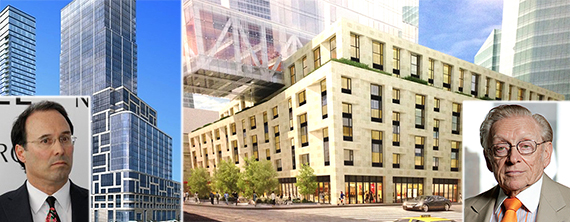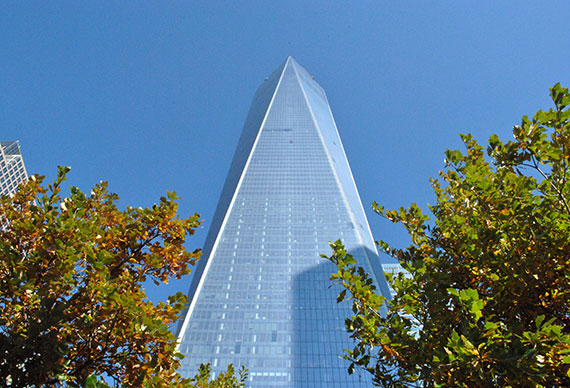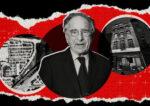Trending
TRD‘s picks: The biggest real estate stories of 2014
One last look at a remarkable year in the property business in NYC

It was a tumultuous year in the real estate sector in New York in 2014 – in other words, business as usual. The stories that dominated the headlines varied wildly, from a flood of overseas investment to the completion of several long-anticipated developments to the murder of a Brooklyn landlord.
Not surprisingly, selecting the biggest, most compelling stories in a remarkably eventful year is no small task. Nevertheless, The Real Deal’s editors and reporters set out to pick the events that we believe stood out in 2014.
Here then, is what we came up with: our compilation of the 10 biggest real estate stories of the year, listed in no particular order.

From left: Renderings of 40 Riverside Boulevard and 1 West End Avenue (inset: Gary Barnett and Larry Silverstein)
Poor door uproar
Extell Development sparked the controversy over plans for a so-called “poor door,” or separate entrance for affordable housing tenants, at its 40 Riverside Boulevard development. But the issue didn’t stop there. Nearby, developer Larry Silverstein’s 42-story 1 West End Avenue will also have a so-called poor door. Long Island City’s new Q41 building reportedly is blocking the large terraces of a few affordable units.
While local officials have vowed not to approve more separate entrances, Mayor Bill de Blasio has criticized the use of poor doors, and his position underscores tension between developers and the administration, which seeks to build or preserve 200,000 affordable housing units over 10 years.
Extell’s Gary Barnett defended the use of the poor door, arguing that it wouldn’t make sense to incorporate affordable rental units into the tower without it, and that the income from the condos subsidizes the affordable-housing component.
Overseas investors flock to New York
Chinese buyers became the largest group of foreign investors snapping up Manhattan properties in 2014, as wealthy buyers from Russia, Brazil and elsewhere continued to invest in New York real estate. Overall foreign investment came in various forms.
As the second most popular spot for well-heeled buyers to purchase a second home, New York City is home to 17,400 pieds-à-terre owned by millionaires – many of them from overseas. International buyers continued to invest in large-scale New York development, as well. During the first half of the year alone, overseas investors spent more than $600 million on outer borough real estate. Chinese firm Greenland Holdings Group invested in the Atlantic Yards project, now called Pacific Park.
This past summer, the State Department announced it was on track to reach its limit of 10,000 EB-5 visas, which offers a visa in exchange for a $500,000 investment and creation of jobs. The program has been tapped by New York developers, including Related Companies which raised a record $600 million through the program to finance three towers on the Far West Side. Forest City Ratner Companies raised more than $475 million to pay for its project near the Barclays Center in Brooklyn.

One World Trade Center (Credit: Kerry Barger)
One World Trade opens
Eight years after the Port Authority of New York & New Jersey and the Durst Organization broke ground on One World Trade Center, the $3.8 billion office tower finally opened its doors in November. At a symbolic 1,776 feet, the 104-story building is the tallest in the western hemisphere. Condé Nast, which is slated to occupy floors 20 through 44, was the first tenant to move in. But the staff of the publishing giant soon encountered unexpected occupants – rats, which Vogue chief Anna Wintour termed an “infestation.”
Luxury prices soar
From ultra-lavish Condos On 57th Street to $100 million penthouses, 2014 was a year that luxury prices continued to rise. And rise.
A year-end report by Olshan Realty said the city’s luxury market hit a whopping $11.3 billion in sales contracts in 2014 thanks to price increases in every type of inventory. Two eye-popping co-op sales broke the previous record of $54 million set in 2012. In 2014, hedge-funder Israel Englander paid $71.3 million for a co-op at 740 Park Avenue while Egyptian billionaire Nassef Sawiris paid $70 million for Edgar Bronfman’s former penthouse at 960 Fifth Avenue.
Following the lead of Extell Development at One57, where condos sold for $55.5 million and $53 million during the last few weeks of the year, other luxury condos are coming to Midtown’s Billionaire’s Row, including Macklowe Properties’ 432 Park. Meanwhile, Zeckendorf Development will ask $130 million for a penthouse at 520 Park and a penthouse at the Woolworth Residences is asking $110 million.

From left: John Banks and Steven Spinola
Spinola steps down from REBNY
At the perch of the Real Estate Board of New York, the wheels were in motion for a changing of the guard. Shortly after Steven Spinola announced in June he would be stepping down as president in 2015 after nearly three decades at the board, the trade group launched a search for his successor. Jack Lusk of the executive recruiting firm Harris Rand Lusk advised REBNY.
By December, REBNY named a new president: John Banks, vice president of government relations at Consolidated Edison. James Whelan, a senior vice president of public affairs at REBNY, and Ramon Martinez, deputy chief of staff to City Council Speaker Melissa Mark-Viverito, had also been considered for the job.
Drama at Town
Andrew Heiberger, co-chair of Town Residential, spent much of the year away from the brokerage. He departed as CEO in January after a much-publicized falling out with co-chair Joseph Sitt. In his absence, Jeff Appel oversaw aspects of the operation and frequently met with Sitt to devise a long-term strategy for the firm. But Appel was unexpectedly terminated on Oct. 1 — the same day that Heiberger surprisingly returned to power as CEO of the firm.
Town’s plans to expand abroad, however, hit a snag. Town said in September it would open its first international location in Central London with Lindsey Owen at the helm. A month later, however, Owen jumped ship to Douglas Elliman. The brokerage also had its share of victories. As a result of Town’s lawsuit against former marketing director Nicole Oge, a judge ruled that she violated her non-compete agreement when she took a job with Elliman.

Menachem Stark (right) with his wife and son
Murder of Menachem Stark
When the body of Menachem Stark was discovered in a Long Island dumpster in January, the story quickly became front-page fodder for the city’s tabloids. Speculation ran rampant about who wanted the Brooklyn landlord and developer dead.
Stark, a 39-year-old husband and father of seven who was a member of the close-knit Satmar Hasidic Jewish community, owned around 1,000 apartment units in Brooklyn with his business partner Israel Perlmutter. The portfolio had a number of building violations, and Stark was quickly depicted as a slumlord. On top of that, he and Perlmutter were involved in a number of foreclosures, leading some to believe Stark was murdered as a result of business dealings that went sour.
In the spring, however, police arrested and charged 26-year-old construction worker Kendel Felix with Stark’s kidnapping and murder. Felix, who pleaded not guilty, told authorities Stark died during a botched robbery attempt, according to court documents.

From left: WeWork’s Adam Neumann, Urban Compass’ Robert Reffkin and Hightower’s Donald DeSantis, Brandon Weber and Niall Smart
Tech startups
The biggest news on the real estate tech scene this year may have been Urban Compass’ latest round of investment funding, but Ori Allon and Robert Reffkin’s firm wasn’t the only one making a splash in 2014.
The tech-centric brokerage was valued at $360 million back in July on the back of $40 million it raked in through its Series-B fundraising round. Urban Compass was just one of the local startups helping New York crawl out from under Silicon Valley’s shadow.
In the two-year period ending during the second quarter of 2014, New York-based startups raised $56 million, according to a report released in July by the real estate consulting firm RE: Tech. And while that figure was only about three quarters the size of Silicon Valley’s haul, it represented a nearly 78-percent growth year-over-year while firms based in the West Coast hub saw their total funding drop 18 percent.
Another local firm making a splash was the cloud-computer Hightower, which allows commercial landlords and brokers to share leasing data on web and mobile platforms. The company raised $6.5 million in Series A funding in August eight months after closing out 2013 with $2.1 million.
A non-tech real estate startup, WeWork, provided perhaps the most dramatic sign of the rising influence of new companies in the property market in New York. A funding round for the provider of shared space valued the company at $5 billion.
High Line completed
It was nearly two decades in the making, but 2014 saw the completion of the third and final leg of the High Line, opening all 22 blocks of the park to visitors and capping off the attraction that transformed real estate on the Far West Side.
The newest section of the park opened in September, 15 years after Chelsea residents Joshua David and Robert Hammond founded the non-profit Friends of the High Line to preserve and re-adapt the elevated railway.
The park now snakes west toward the Hudson River, around Related Group’s Hudson Yards project to gritty areas yet untouched by the West Chelsea gold rush. Not surprisingly, property owners are seizing the opportunity to cash in on investors willing to speculate on potential upzonings. The park continues to fuel frenzied investment in the area, as illustrated by Ziel Feldman’s $800 million-plus buy in November of a development site near the park’s first section, which opened in 2009.

From left: Bob Knakal, Paul Massey and Edward Forst
Cushman buys Massey Knakal
New York City real estate firms saw a number of shakeups this year, but none was bigger than Cushman & Wakefield’s $100 million purchase of the mid-market dominator Massey Knakal.
Paul Massey and Bob Knakal raised some eyebrows in November when, as the company got ready to celebrate its 25th anniversary, the two hired Perella Weinberg Partners to sell either a 49 percent stake in the company or the whole thing outright.
Some of the biggest names in commercial real estate reportedly showed interest in the company, such as CBRE and DTZ. But Cushman came through as the winner in early December with its $100 million bid to buy the entire brokerage.
(Rich Bockmann, Mark Maurer and E.B. Solomont contributed to this article)




